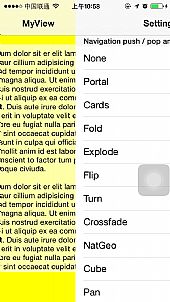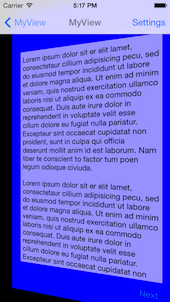With iOS 7 you can easily create custom view controller transitions that can be used in a range of contexts (push, pop, modal …). This project provides a library of custom animations which can be dropped directly into your project. It also has a number of 'interaction controllers' which can be used with any of the custom animations in order to make your transitions interactive.
The library currently contains the following animations, which can be made interactive with either a swipe or pinch gesture.
| Flip | Fold | Crossfade | Explode |
|---|---|---|---|
 |
 |
 |
 |
| Turn | Cards | NatGeo | Portal |
 |
 |
 |
 |
| Cube | Pan | ||
 |
 |
- A brief introduction to custom transitions
- Adding custom transitions to your project
- Transitions library
The following provides a very brief introduction to the concepts, for more detailed coverage I would thoroughly recommend reading Chapter 3 of iOS 7 By Tutorials - which I wrote! (I've heard the other 15 chapters are pretty good too ;-)
There are two key classes involved in a custom transition:
- Animation controller - this class is responsible for performing the custom transitions. When you indicate that a custom transitions should be used, you provide an animation controller. This class performs the required animation, then informs the framework when it has completed.
- Interaction controller - this class is responsible for managing interactive transitions - these are transitions that typically controlled by a gesture, allowing the user to swipe, pinch or perform some other action to navigate between view controllers. Importantly, interaction controllers allow transitions to be cancelled, i.e. a user can start the navigation, change their mind, and reverse it!
NOTE: Animation and interaction controllers are entirely independent, this means you can wire up any interaction controller with any animation controller - which is pretty awesome.
This sections gives a brief overview of the steps required to add custom view controller transitions to your project. You might also want to look at the code for the demo app (in the TransitionsDemo folder) for reference. If you already know how the iOS 7 custom view controller transitions work, feel free to skip this section!
There are a couple of ways you can incorporate transitions from this library into your code:
- CocoaPods - simply add a reference to VCTransitionsLibrary to your pod file.
- Manual file copy - if you are not using CocoaPods, you can simply copy the required files into your project. The
AnimationControllersandInteractionControllersfolders contain all the code that is required.
The AnimationControllers folder contains a number of animate controllers, which provide custom transitions, which can be integrated into your project as follows:
The UIViewControllerTransitioningDelegate protocol is used to supply animation controllers for present / dismiss transitions. When a view controller is presented or dismissed the transitioningDelegate property of the view controller being presented or dismissed is used to supply this delegate. Simply return one of the animation controllers in response to the animationControllerForPresentedController: presentingController: sourceController: message for presenting, and animationControllerForDismissedController: for dismissing.
The UINavigationControllerDelegate protocol has methods that can be used to provide animation controllers. Simply return an animation controller in response to the navigationController: animationControllerForOperation: fromViewController: toViewController: message.
Notice that this message has an 'operation' argument that allows you to return different animations for push and pop operations. All of the animation controllers in this library subclass CEReversibleAnimationController which allows you to play the animation in reverse. This is commonly used in conjunction with the navigation controller as follows:
- (id<UIViewControllerAnimatedTransitioning>)navigationController:
(UINavigationController *)navigationController
animationControllerForOperation:(UINavigationControllerOperation)operation
fromViewController:(UIViewController *)fromVC
toViewController:(UIViewController *)toVC {
// reverse the animation for 'pop' transitions
_animationController.reverse = operation == UINavigationControllerOperationPop;
return _animationController;
}The UITabBarControllerDelegate protocol has methods that can be used to provide animation controllers. Simply return an animation controller in response to the tabBarController: animationControllerForTransitionFromViewController: toViewController:
message.
In order to determine the animation direction, you can compare the indices of the two view controller as shown below:
- (id <UIViewControllerAnimatedTransitioning>)tabBarController:(UITabBarController *)tabBarController
animationControllerForTransitionFromViewController:(UIViewController *)fromVC
toViewController:(UIViewController *)toVC {
NSUInteger fromVCIndex = [tabBarController.viewControllers indexOfObject:fromVC];
NSUInteger toVCIndex = [tabBarController.viewControllers indexOfObject:toVC];
_animationController.reverse = fromVCIndex < toVCIndex;
return _animationController;
}Interaction controllers work in conjunction with an animation controller in order to make a transitions interactive, i.e. allow a user to control a transitions using gestures. This interactivity allows a use to move forwards, backwards and even cancel a transitions.
The interaction controller is responsible for adding gesture recognisers to the view and triggering the navigation in response to gestures from the user.
The UIViewControllerTransitioningDelegate protocol that is used to supply animation controllers is also used to supply interaction controllers. An example implementation, that uses a swipe interaction together with a flip animation, is show below:
// instance variables, typically instantiated in your init method
CEFlipAnimationController *_animationController;
CESwipeInteractionController *_interactionController;
- (id<UIViewControllerAnimatedTransitioning>)
animationControllerForPresentedController:(UIViewController *)presented
presentingController:(UIViewController *)presenting
sourceController:(UIViewController *)source {
// allow the interaction controller to wire-up its gesture recognisers
[_interactionController wireToViewController:presented
forOperation:CEInteractionOperationDismiss];
_animationController.reverse = NO;
return _animationController;
}
- (id<UIViewControllerAnimatedTransitioning>)
animationControllerForDismissedController:(UIViewController *)dismissed {
_animationController.reverse = YES;
return _animationController;
}
- (id<UIViewControllerInteractiveTransitioning>)
interactionControllerForDismissal:
(id<UIViewControllerAnimatedTransitioning>)animator {
// provide the interaction controller, if an interactive transition is in progress
return _interactionController.interactionInProgress
? _interactionController : nil;
}Note that in the above code the interactionInProgress property of the interaction controller is checked. This is because your might want to allow the user to dismiss the view controller using a button as well as via an interaction. Also, you must tell the interaction controller the operation it should perform (i.e. pop, dismiss).
The UINavigationControllerDelegate protocol also has an equivalent method for returning interactions controllers. A typically implementation, which follows the same pattern as above, is shown:
// instance variables, typically instantiated in your init method
CEFlipAnimationController *_animationController;
CESwipeInteractionController *_interactionController;
- (id<UIViewControllerAnimatedTransitioning>)
navigationController:(UINavigationController *)navigationController
animationControllerForOperation:(UINavigationControllerOperation)operation
fromViewController:(UIViewController *)fromVC
toViewController:(UIViewController *)toVC {
// wire the interaction controller to the to- view controller
[_interactionController wireToViewController:toVC
forOperation:CEInteractionOperationPop];
_animationController.reverse = operation == UINavigationControllerOperationPop;
return _animationController.reverse;
}
- (id <UIViewControllerInteractiveTransitioning>)
navigationController:(UINavigationController *)navigationController
interactionControllerForAnimationController:(id <UIViewControllerAnimatedTransitioning>)animationController {
// provide the interaction controller, if an interactive transition is in progress
return _interactionController.interactionInProgress
? _interactionController : nil;
}The UITabBarControllerDelegate protocol has an equivalent method for returning interactions controllers. As with the navigation controller example above, the interaction controller needs to add its gesture recognisers to the view controllers that the tab bar controller navigates between. Unfortunately the tab bar delegate methods don't get fired when the first view controller is presented, so I opt for a slightly messier implementation using Key-Value observing:
@implementation TabBarViewController {
CEFoldAnimationController *_animationController;
CESwipeInteractionController *_swipeInteractionController;
}
- (id)initWithCoder:(NSCoder *)aDecoder {
if (self = [super initWithCoder:aDecoder]) {
self.delegate = self;
// create the interaction / animation controllers
_swipeInteractionController = [CESwipeInteractionController new];
_animationController = [CEFoldAnimationController new];
_animationController.folds = 3;
// observe changes in the currently presented view controller
[self addObserver:self
forKeyPath:@"selectedViewController"
options:NSKeyValueObservingOptionNew
context:nil];
}
return self;
}
- (void)observeValueForKeyPath:(NSString *)keyPath ofObject:(id)object
change:(NSDictionary *)change
context:(void *)context
{
if ([keyPath isEqualToString:@"selectedViewController"] )
{
// wire the interaction controller to the view controller
[_swipeInteractionController wireToViewController:self.selectedViewController
forOperation:CEInteractionOperationTab];
}
}
- (id <UIViewControllerAnimatedTransitioning>)tabBarController:(UITabBarController *)tabBarController
animationControllerForTransitionFromViewController:(UIViewController *)fromVC
toViewController:(UIViewController *)toVC {
NSUInteger fromVCIndex = [tabBarController.viewControllers indexOfObject:fromVC];
NSUInteger toVCIndex = [tabBarController.viewControllers indexOfObject:toVC];
_animationController.reverse = fromVCIndex < toVCIndex;
return _animationController;
}
-(id<UIViewControllerInteractiveTransitioning>)tabBarController:(UITabBarController *)tabBarController interactionControllerForAnimationController:(id<UIViewControllerAnimatedTransitioning>)animationController
{
return _swipeInteractionController.interactionInProgress ? _swipeInteractionController : nil;
}
@endThe following is a graphical illustration of the various transitions. All animation controllers have a duration property that configures the animation duration.
Animates between the two view controllers using a paper-fold style transition. You can configure the number of folds via the folds property.
Animates between the two view controllers using a page-flip transition.
Animates between the two view controllers using transition inspired by City Guides by National Geographic. It's an adoptation of MHNatGeoViewControllerTransition to iOS7 APIs.
Animates between the two view controllers by performing a 3D flip, to reveal the destination view on the back.The turn animation has a flipDirection property that specifies the turn orientation.
Animates between the two view controllers by performing a simple cross-fade.
Animates between the two view controllers by slicing the from- view controller into lots of little pieces, then randomly spinning and shrinking them.
Gives the impression of one view controller pushing the other to the back. It looks a lot more cool than these static screenshots!
(courtesy of Tope - AppDesignVault)
The top-most view controller parts in the middle to reveal the view controller beneath.
(courtesy of FreddyF)
This transition gives the appearance of rotating the faces of a cube.
(courtesy of Andrés Brun)






























